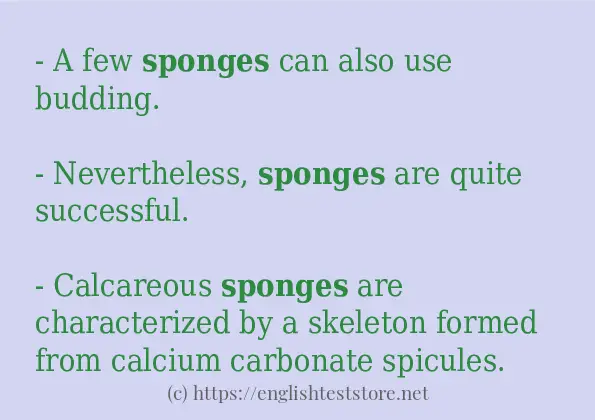How to use in-sentence of “sponges”:
– A few sponges can also use budding.
– Nevertheless, sponges are quite successful.
– Calcareous sponges are characterized by a skeleton formed from calcium carbonate spicules.
– Until synthetic sponges were invented, they were also used as cleaning tools, for painting, and as contraceptives.
– Hexactinellid sponges are sponges with a skeleton made of four- and/or six-pointed silaceous spicules, often referred to as glass sponges.
– Syconoid sponges are larger and more complex than asconoid sponges.
– Some scientists said they thought a similar gene, ANTP, the NK gene, and the Cdx Parahox gene were also in sponges in the phylum Porifera, but for now, Parahoxozoa does not have sponges in it.
– Glass sponges of the class Hexactinellida typically live in deep sea environments and may also be found in Antarctic regions.

Example sentences of “sponges”:
- When the conditions are bad, some sponges can also grow lumps of unspecialised cells.
- Demosponges of the class Demospongiae are the most numerous of the sponges containing 90 to 95 percent of Porifera species.
– When the conditions are bad, some sponges can also grow lumps of unspecialised cells.
– Demosponges of the class Demospongiae are the most numerous of the sponges containing 90 to 95 percent of Porifera species.
– Some giant sponges can reach heights of seven feet, while the smallest sponges reach heights of only two-thousandths of an inch.
– Most known carnivorous sponges have completely lost the water flow system and choanocytes.
– A number of animals use these sponges for shelter and protection including shrimp.
– Since sponges are non-motile, they are typically found attached to rocks or other hard surfaces.
– Although multicellular, sponges only have a few different types of cells, some of which may migrate within the organism to perform different functions.
– Unlike most animal organisms which exhibit some type of body symmetry, such as radial, bilateral, or spherical symmetry, most sponges are asymmetric, exhibiting no type of symmetry.
– This is vital as sponges do not have a circulatory system, respiratory system, digestive system, muscular system, or nervous system as do many other animals.
– Regeneration also enables sponges to repair and replace damaged or severed body parts.
– I know that our article about sponges is not great.
– The most familiar representative of the glass sponges is the Venus’ flower-basket.
– Asconoid sponges have the simplest organization consisting of a porous tube shape, an osculum, and an open internal area that is lined with choanocytes.
– Most sponges reproduce sexually.
– The three main classes of sponges include glass sponges.
– Members of the Chlorophyta also form symbiosissymbiotic relationships with protozoa, sponges and cnidarians.
– Most natural sponges used for cleaning today come from the Mediterranean and the Caribbean.
– In fragmentation, new sponges develop from pieces that have fragmented from the body of the parent sponge.
– Among animals, sponges show the simplest organization, having a single germ layer.
